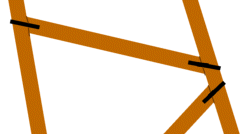Types of support | Flexible supports | Rigid framed supports | Fixtures and fastenings | Metal brackets | Cables
Knee braces | Dangerous things to avoid | Non-flat surfaces | Improving stability | Building without trees
Rigid framed supports
Rigid framed supports are the easiest way to hold up a treehouse because problems of movement are ignored. Make sure you have read 'What type of support will I need?' and have determined that your situation is suitable for a rigid framed support network.

You should be considering this technique if you have a small tree (like an apple tree) or are building near the top of a set of trees where the trunks/branches are in the region of 6" diameter. In these cases flexible joints do not operate ideally or with much significant advantage.
The first thing is that everything to do with the support network must be geared towards resisting motion in the branches. Design your supports using triangular arrangements of beams wherever possible. Triangles are the most rigid building shape. Beams should be 2x6, 4x6, or larger to withstand forces that will build up in the wind. Bolts should all be at least ¾" thick. You can use lag bolts (also known as coach bolts) or standard bolts that go right through the branches to secure the beams to the tree, but never nails or screws.

Beams in the network are secured using 6" lag bolts and should fit together cleanly as shown in these diagrams. Once you have a solid foundation layer, you can fit joists between the beams with nails or screws and cover with a floor. Plywood is recommended (¾" or thicker exterior quality) because it is highly effective at transmitting forces throughout the support network it is attached to. Use large nails or screws to secure it to the joists and beams so it is well anchored and can't become loose.
If you have the time, load your new platform with sandbags, bricks, rocks, barrels of water or whatever else you can find. Test your platform with at least 150% of the expected final load (ie, the weight of the rest of the house plus any people inside). Leave this up there for a few days, preferably in stormy weather. Now examine all the joints and beams very carefully for any sign of damage. If everything looks good, go ahead with the rest of your building. Otherwise you will have to reconsider your supports and possibly add more support points or some flexible joints. If you have large spans or spans that take a lot of weight, you should fit either cable supports or knee braces to take some of the load. You can see some examples on the single tree support example page.
Types of support | Flexible supports | Rigid framed supports | Fixtures and fastenings | Metal brackets | Cables
Knee braces | Dangerous things to avoid | Non-flat surfaces | Improving stability | Building without trees
